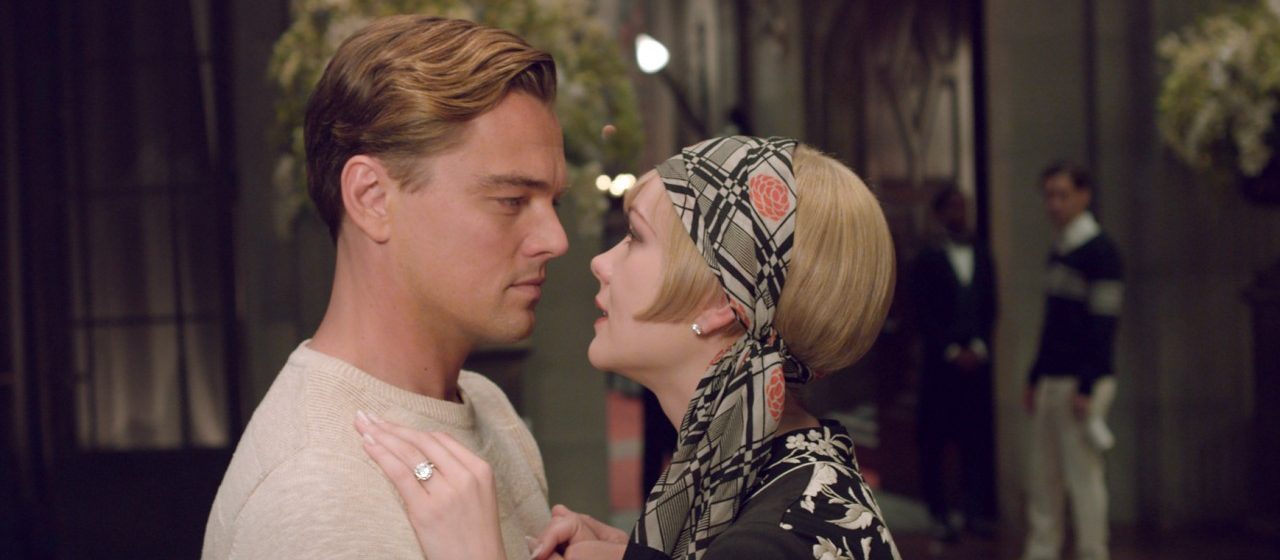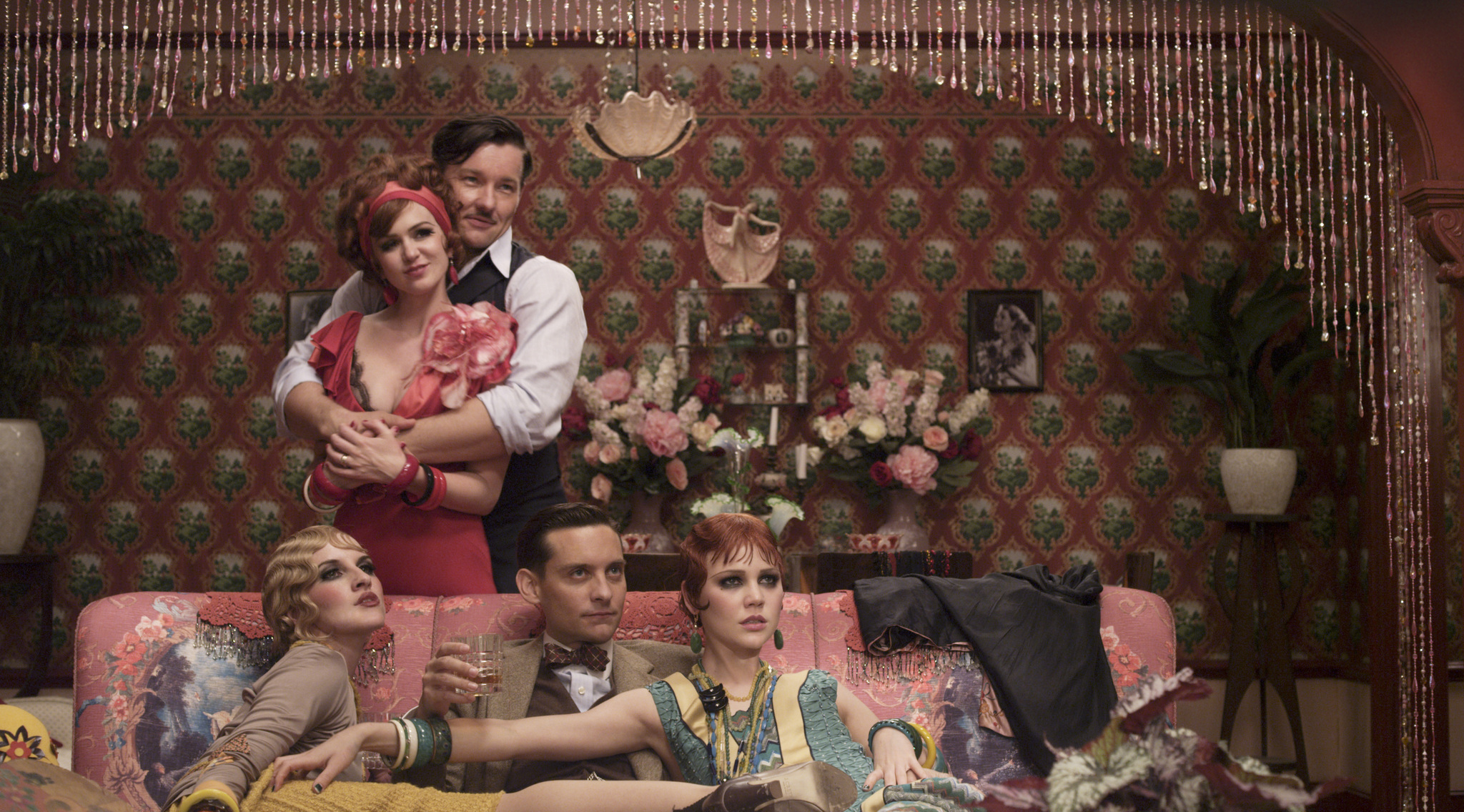

“So we beat on, boats against the current, borne back ceaselessly into the past.”
Despite some truly excellent performances, Baz Luhrmann’s half-modernized adaptation of F. Scott Fitzgerald’s classic novel is not very good. In some ways, the film strives valiantly to be a faithful adaptation, for better or worse, keeping the general plot (albeit with some silly deviations) and period setting. In others, it makes a mockery of the novel by squandering any chance of the subtlety or beauty found on the written page in favor of glitz. In a misguided attempt at juxtaposing the old and the new, we find ourselves assaulted with a mish-mash of excessive CGI, hip hop music, choppy editing, and lamely implemented excerpts from the book. The filmmakers may have been trying to match the book’s ethereal sense of unreality with this trickery, but it feels like a hollow shell of a film coated in sugar.
In order to give the film a frame that will allow the director to literally put text on the screen so that we know we are watching a “literary” film, Nick Carraway (Tobey Maguire) tells the story of Jay Gatsby (Leonardo DiCaprio) from a sanitarium. This narrative device is not found in the book, but Nick’s doctor encourages him to write his thoughts down and thus we have our narrative frame. During brief interludes in the film, while Nick dutifully pecks away at his typewriter, or reflectively mumbles as he looks out of a computer-generated frosty window, his words are projected onto the screen.1 It would be silly if done only once, but it becomes trite by the end of the film. Likewise, the green light and the eyes of Dr. T. J. Eckleburg—so symbolic and imbued with meaning in the book—lose any sense of significance due to overexposure in Luhrmann’s hands.
In case you are unfamiliar with the story because you skipped a year of high school or something, a brief recap of the main narrative: Nick Carraway is a failed writer who’s moved to the fictional West Egg on Long Island, New York to pursue a career in finance. Soon after settling into his small cottage, Nick shares a meal with his cousin Daisy (Carey Mulligan), her husband Tom (Joel Edgerton), and Daisy’s enigmatic bestie and professional golfer Jordan (Elizabeth Debicki). Nick soon discovers that his rich, mysterious neighbor, Jay Gatsby, regularly throws lavish parties at his mansion. Though these parties are open to everyone and half the population of New York simply shows up at the right time, Nick believes himself to be the sole recipient of a personal invitation from Gatsby. He marvels at this fact to a fellow party-goer who turns out to be the man himself. “I’m afraid I haven’t been a very good host, old sport,” he says. “You see, I’m Gatsby.” The introduction isn’t as drawn out and memorable as the one in the book (it’s a lot easier to hide a character’s identity on the page) but Leo makes the most of his first appearance. As the two men begin to form a peculiar bond, we learn that his whole persona is just a charade—the parties mean nothing to him, and the only reason he put them on, and also the only reason he befriends Nick, is because he was once in love with Daisy and hopes to win her back. With the help of Nick, the two begin secretly seeing each other until things come to a head with a car wreck and a murder-suicide.

DiCaprio plays Gatsby with bravura, balancing the mystery of the rags-to-riches facade and the underlying humanity of the yearning lover who possesses inhuman optimism and a wholehearted belief that he can relive the past. We witness the actor in several modes—the consummate gentleman, the businessman, the flustered romantic, the provoked psycho, the confused reject. The rest of the cast is excellent as well—Tobey Maguire moves through the whole thing with an aura of detached innocence, Carey Mulligan gets to be an emotional mess for most of the runtime, and Joel Edgerton handles the hypocritical Tom Buchanan with ease. As Myrtle and George Wilson, Isla Fisher and Jason Clarke also do solid work.
Unfortunately, the fine acting is obscured by the overbearing direction. Most glaring is the inconsistent application of period aesthetics. Fitzgerald’s novel is intimately tied to the excess of the Roaring Twenties. Gatsby’s personal history as an Oxford man and a bootlegger must remain, the characters must drive expensive cars and constantly imbibe, and live jazz must be played at the parties. Too much of Fitzgerald’s novel is specific to its era for Luhrmann to wrench it into modern times like he did with Romeo + Juliet. But he certainly tries to do it as much as he can. The overdone CGI is pervasive, giving the camerawork a sheen of artificiality.2 This is worsened by the hyperactive editing that barely gives the viewer a second to orient themselves in a shot before skipping to the next, and the next, and so on. It’s really a shame because the sets that one does get an extended peek at look great—it’s just that we only see them fleetingly.
For some reason, Jay-Z was tapped to craft the soundtrack. The tracklist features contributions from a number of current artists like The xx, Lana Del Rey and Gotye, and Jay-Z, of course, mixed with composer Craig Armstrong’s classical score. I found that this proved to be a tasteless mix of styles that clashed way too much for me to take seriously, even though I mostly enjoy the separate styles in isolation. In an interview with Rolling Stone, Luhrmann said, “The question for me in approaching Gatsby was how to elicit from our audience the same level of excitement and pop cultural immediacy toward the world that Fitzgerald did for his audience? And in our age, the energy of jazz is caught in the energy of hip-hop.”3 This helps to explain his aim, but he only goes halfway by including hip hop. If he wanted to do the modernizing thing, then he should have gone for it—Gatsby should have made his fortune as a tech founder, not as a bootlegger, etc. (I probably wouldn’t have even bothered with that movie, but that’s besides the point). Instead we get this half-and-half thing that just doesn’t work. Not to go off on a tangent, but I’m not against this mix of styles in principle. Django Unchained is set in the 1800s and features music from Rick Ross and Tupac Shakur—I find the moments when those songs appear in the film to be absolutely superb. When I realized how much I disliked the modern soundtrack in Gatsby I thought it might be a personal thing, but on further reflection and with a clear counter-example, I’m gonna have to say it’s just poor execution/song selection.
I’m not some kind of fanatic who thinks the book is some kind of sacred American treasure. I’ve enjoyed it the few times I’ve read it, but I don’t think it’s “the great American novel” or anything like that. But it was at least poetic, intricate, iconic, and engaging. The film is the opposite. It churns through the plot, heaps a heavy dose of contemporary music and trendy CGI tricks on top, then adds quotes from the novel and calls it a day. It’s a real shame that such a talented cast is overshadowed by the poor direction, but that’s how I see it.
1. I’m pretty sure, but didn’t check, that all of the words that appear on the screen are lifted straight from the novel. There’s nothing inherently wrong with that but it seems kind of naive to think that putting the literal text of the novel on the screen would lend the film any great sense of poetry or artistry.
2. There was quite a bit of CGI used to make the environment look good, and I’m generally okay with that. But there were way too many instances of having the camera swoop down the side of a building, zoom out from someone’s face to a shot of the entire city, move through windows—the sort of unnecessary stuff that basically tells the audience it is fake.
3. Well, the thing is, The Great Gatsby basically ended Fitzgerald’s career and he died thinking it was a colossal failure. He didn’t elicit excitement and pop cultural immediacy from his audience.
Sources:
Blistein, Jon. “‘Great Gatsby’ Soundtrack Features Jay-Z, Andre 3000, Beyonce”. Rolling Stone. 4 April 2013.
“The Great Gatsby (2013) Visual Effects Before & After Clip [HD]”. Youtube, Roadshow Films. 11 July 2013.